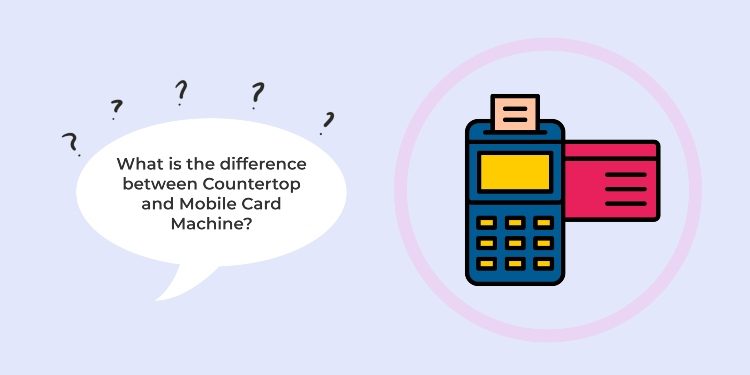The ability to accept credit cards and debit cards has become essential for any modern business. Prior to now, payment devices were often heavy and bulky and difficult to operate. Today, you can choose from a variety of smaller credit card machines that provide the greatest degree of flexibility and ease of use. Countertop card payment machine and mobile card machine – which enable payments by phone – are examples for such card payment solutions.
Almost all card machines can accept debit and credit card payments from customers and transfer them to your merchant account. They are designed to send data to the payment processor over Ethernet, Wi-Fi, or a telephone line. A customer’s bank account is usually debited when they make a payment to your business’s merchant account. In some cases, the credit card processor can deposit your funds directly into your checking account using a merchant account.
Modern credit card machines come in many forms, ranging from simple credit card processing to full-fledged point-of-sale systems. You need to choose a credit card machine that meets the needs of your business if you want to get the most out of your payment processing.
Today’s card machines are conveniently small, making them easy to use in a shop, at a market stall, or if you move from one location to another for work. Countertop card machines and Mobile card machines are popular in the category of card machines. Even though they work for a similar function they do operate differently. In this article, you will get a piece of in-depth knowledge about both machines and know how they differ from one another.
Difference between Countertop and Mobile Card Machine
Taking credit or debit card payments at a fixed checkout area or till requires a countertop credit card machine. This type of card terminal is usually used by retailers, hotels, salons, and those with a fixed point of sale. They are highly reliable and work with a wired internet connection, Bluetooth or a phone line, enabling the user to take card and contactless payments.
An ethernet cable or a traditional phone line can be used to connect a countertop card machine to broadband internet (recommended). There is no risk of downtime with hard-wired connections, and they are highly reliable. Getting a countertop card accepting machine will ensure you are equipped with the tools you need to take payments safely and efficiently from customers.
On the other hand, Card readers are electronic devices used to accept credit and debit card payments from customers in a store. These machines are also known as point-of-sale terminals, card machines, PDQ machines, and chip and pin machines. The magnetic stripe and the electronic chip on all credit cards and debit cards are used by card readers to verify purchases. Customers’ names, card numbers, expiration dates, and security codes are all stored on the stripe and chip of their cards. The information held within the stripe or chip is processed by card readers to complete the transaction.
Mobile Card Machine can be wireless or attached to your till or computer, which makes them more portable. If you need to move from place to place to accept bills, then mobile card readers are the best payment solutions for you.
It is common for people to confuse mobile and countertop card machines as the same electronic device since they offer the same basic functionality. There are significant differences, though, which makes them suitable for different kind of business. Compared to Countertop card machines, mobile card readers are significantly smaller; The majority of them are about the size of a compact feature phone or even a credit/debit card.
Mobile card readers are rectangular and have a much smaller screen than the keypad while Countertop card machines have a bigger screen compared to the card reader, and a pad for the customer to type in the PIN same as the card reader. It is generally necessary to use a mobile or computer application to operate a card reader. But a Countertop Card Machine they do not need any mobile or computer software to function.
As a fixed payment solution Countertop Card Machines aren’t easily transportable. They need wiring hardware to operate. Also, as their name suggests they are a fixed type of payment solution which is intentionally made to work at the same point of transaction. But in the case of Mobile Card Machines, they operate with the help of custom software that can be installed on a laptop or mobile, which makes it transportable. Mobile Card Machines are more vulnerable because they are operated by software on mobile devices or laptops. In today’s world, no software is 100% secure from hackers, hence making Mobile Card Machines less secure than Countertop Card Machine.
Impact of Countertop and Mobile Card Machine
Countertop and Mobile Card Machines are one of the notable outcomes of technology, and their use has steadily increased over time. Technology has become an integral part of people’s lives in the 21st century. Therefore, they place greater emphasis on transactions using credit cards and debit cards.
Additionally, contactless transactions have increased since the arrival of the Coronavirus. EMV has replaced the magistrate premium on credit cards issued by credit card companies. Contactless transactions can be made with credit cards that have an EMV chip.
Technology and situations prompt people indirectly to use card payments as their primary way of transactions than cash payments. Keeping a physical substance as a method of payment is often dangerous. As technology provides more security to banks and digital earnings, it’s no wonder people started using it. This led to the emergence of Countertop and Mobile Card Machines, which revolutionized the way transactions and payments are conducted.
David Prior
David Prior is the editor of Today News, responsible for the overall editorial strategy. He is an NCTJ-qualified journalist with over 20 years’ experience, and is also editor of the award-winning hyperlocal news title Altrincham Today. His LinkedIn profile is here.













































































